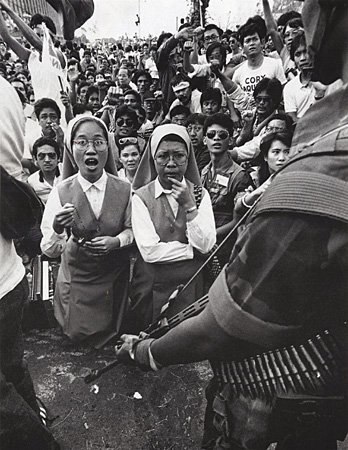Cultural Center of the Philippines
ENCYCLOPEDIA OF
PHILIPPINE ART
Two Nuns of Edsa
24 Feb 1986 / Photograph / Artist: Pete Reyes / The Manila Times
On 23 Feb 1986, people trooped to EDSA and the streets leading to Camps Crame and Aguinaldo, where rebel leaders were holding out in their decisive break from President Marcos. It was day two of the revolt and people were blocking the march of government soldiers and tanks, which were out to crush the mutineers. Representatives of the religious orders were placed in front of a group of protesters as an appeal to the people’s general soft spot for religious leaders. The nuns willingly placed themselves at the forefront, praying with the rest of the crowd. The tanks and soldiers stopped. Government forces retreated.
Two Daughters of Saint Paul sisters, Sr Porfiria Ocariza and Sr Teresita Burias, kneel in front of a throng of demonstrators preventing the onslaught of military tanks at EDSA, main site of the 1986 People Power Revolution. Reporter Ed Lingao is the man with shades reflecting the unseen presence of tanks that were about to crush the people. A mass of persons against a singular guardsman, soldiers menacingly hovering over kneeling people, an anonymous gun-bearer as opposed to distinct individuals, pensive poses in contrast to the openmouthed nuns in front: all these in the midst of anxious faces of the crowd that would soon topple the government. The crowd was reciting the Hail Mary and they were pronouncing the “hail” part of the prayer as this picture was taken, thus explaining the leftmost sister’s half-open mouth.
Taken behind a soldier tasked to disperse civilians, the photograph is a captivating image of the Filipino people’s determination to end the dictatorship. The dictator’s forces were about to attack the people but they were confronted with an indomitable lot who would not concede their space. The image captured the iconic moment in 1986, the play of power and images in the political life of the Philippines. While the photograph may be read as the clash between binary oppositions—good and evil, prayers versus violence, male and female energies—the image also encapsulated the influence of the Catholic church in the political life of the nation. The photograph was first published in Manila Times on 24 Feb 1986 and thereafter reproduced in countless newspapers and magazines reporting the revolution. It was included in books and has become a subject reference for media discussions on EDSA.
Written by JPaul S. Manzanilla
Sources
Mercado, Monina A. 1986. People Power: An Eyewitness History, The Philippine Revolution of 1986. Manila: The James B. Reuter, S.J. Foundation.
Project 28 Days. 1986. Bayan Ko!: Images of the Philippine Revolt. Hong Kong: Project 28 Days Ltd.
Sunday Inquirer Magazine. 1987. “Flattening Experience: The Picture That Went around the World.” 22 Feb, pp. 16-17.
